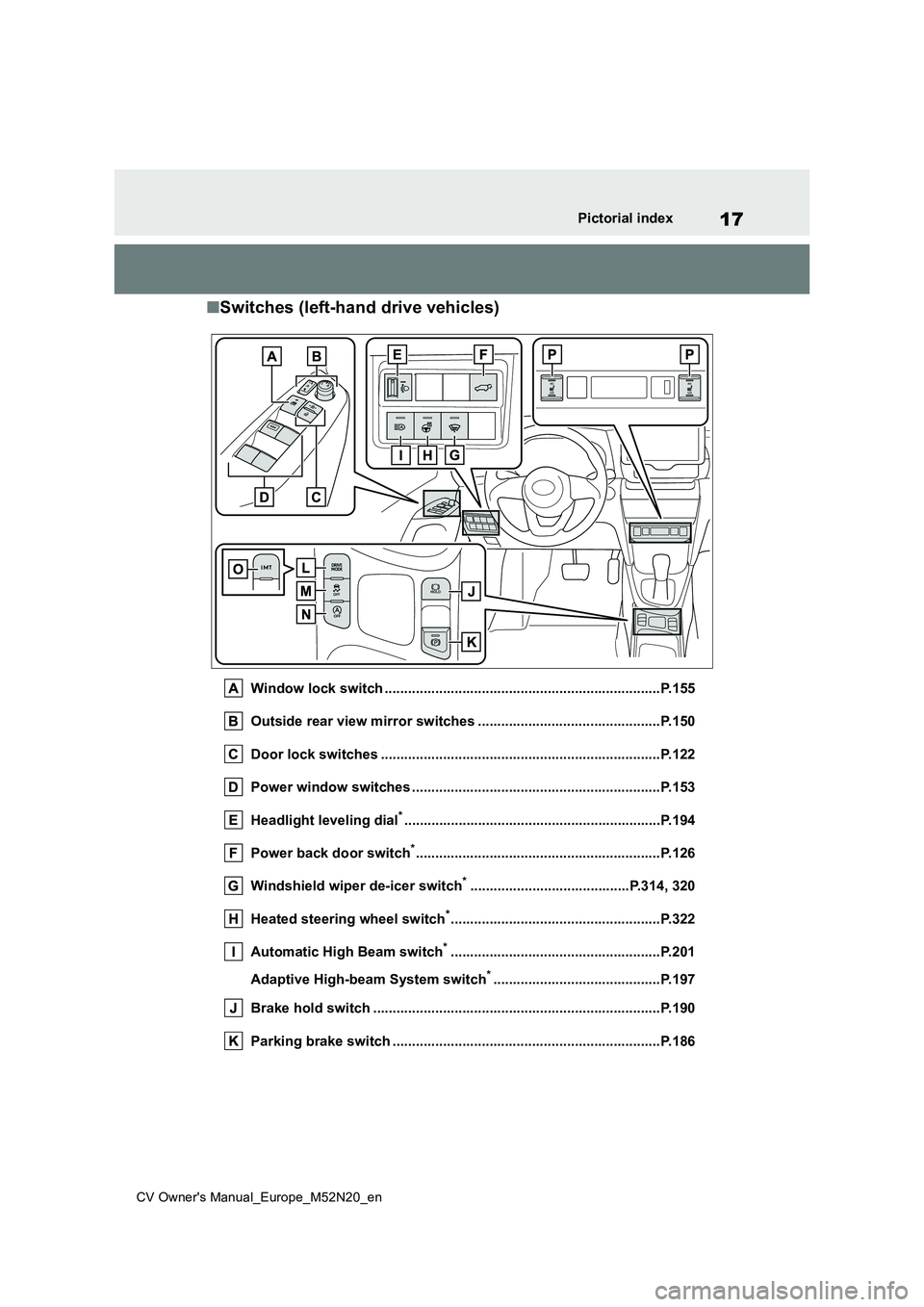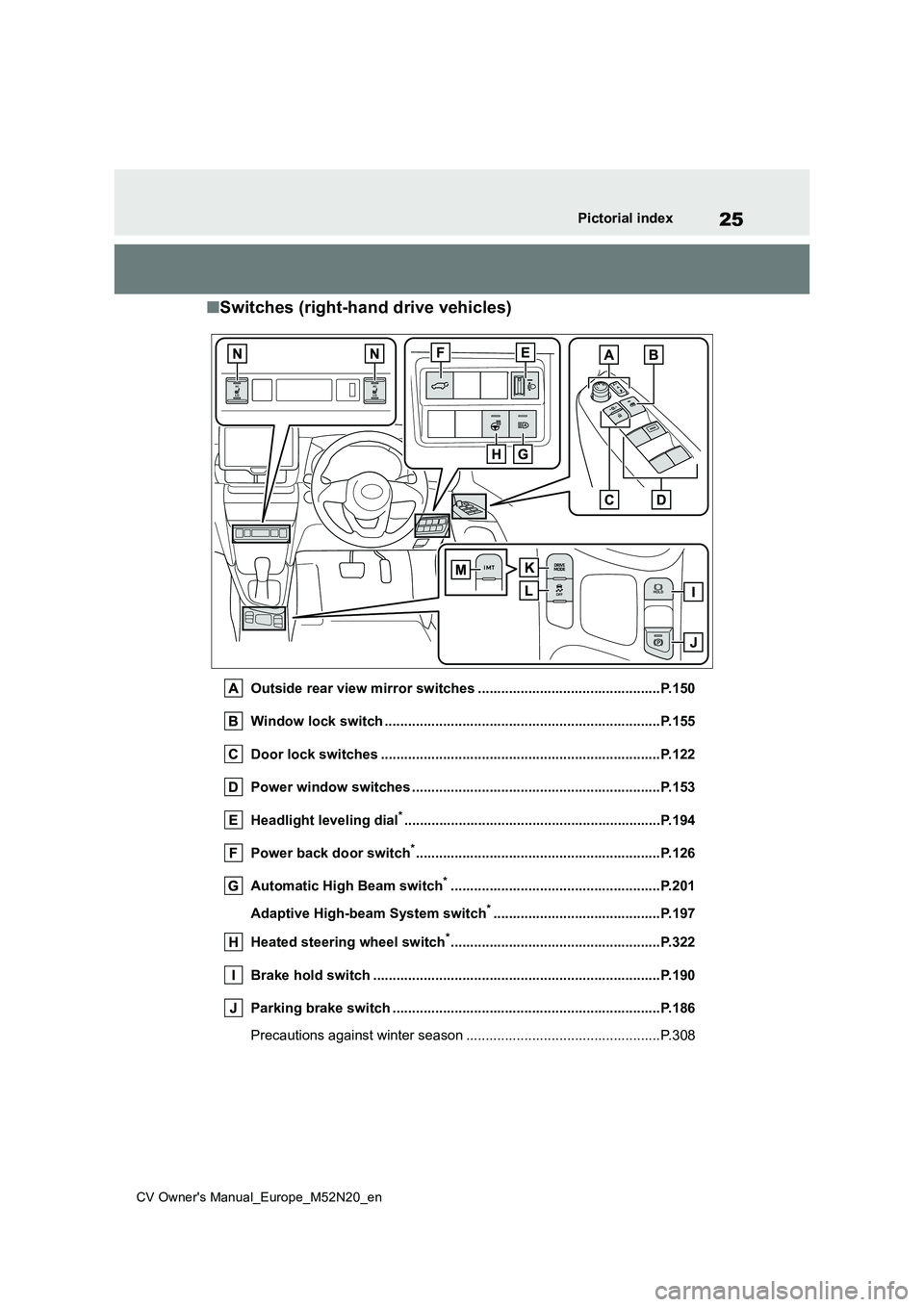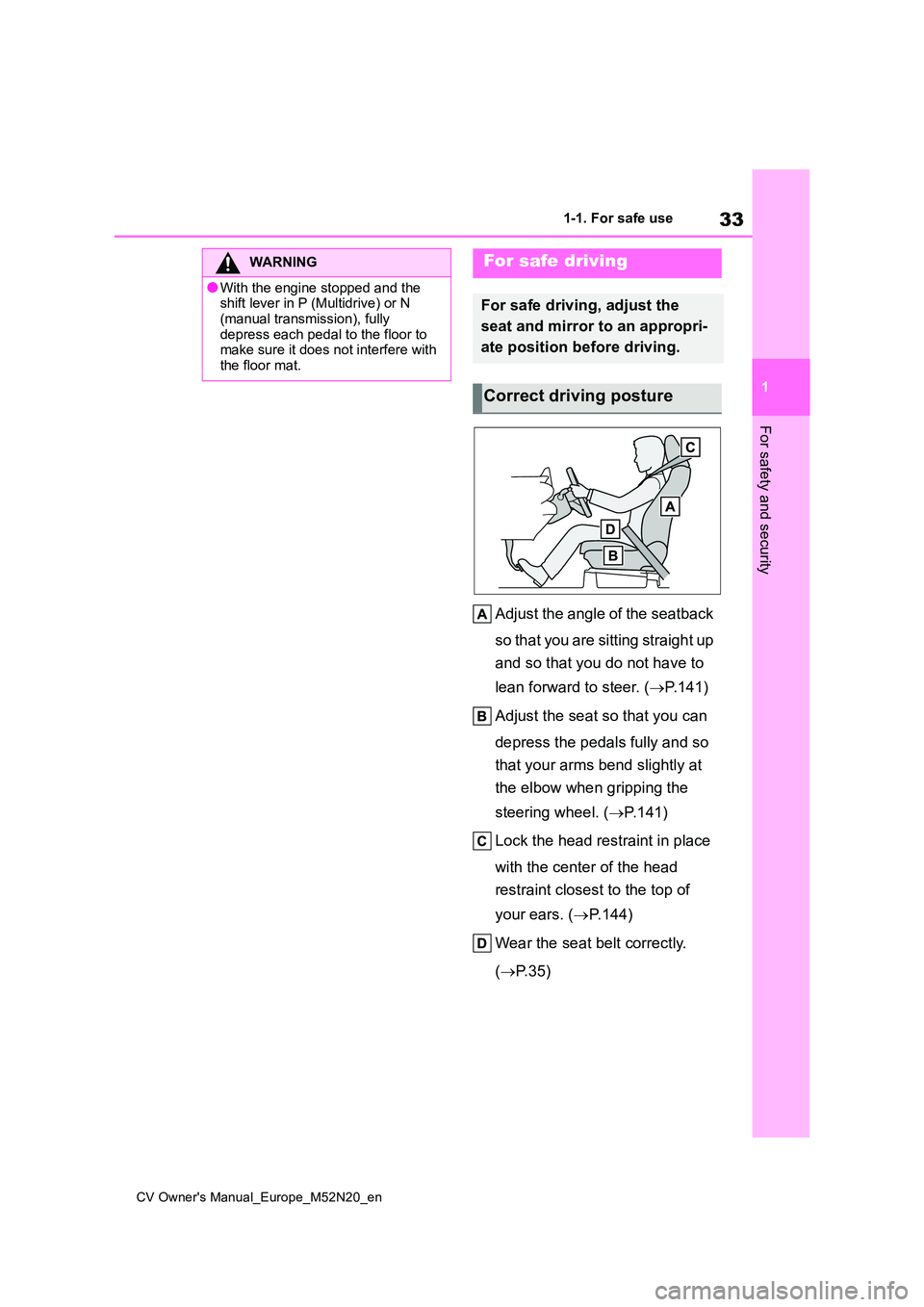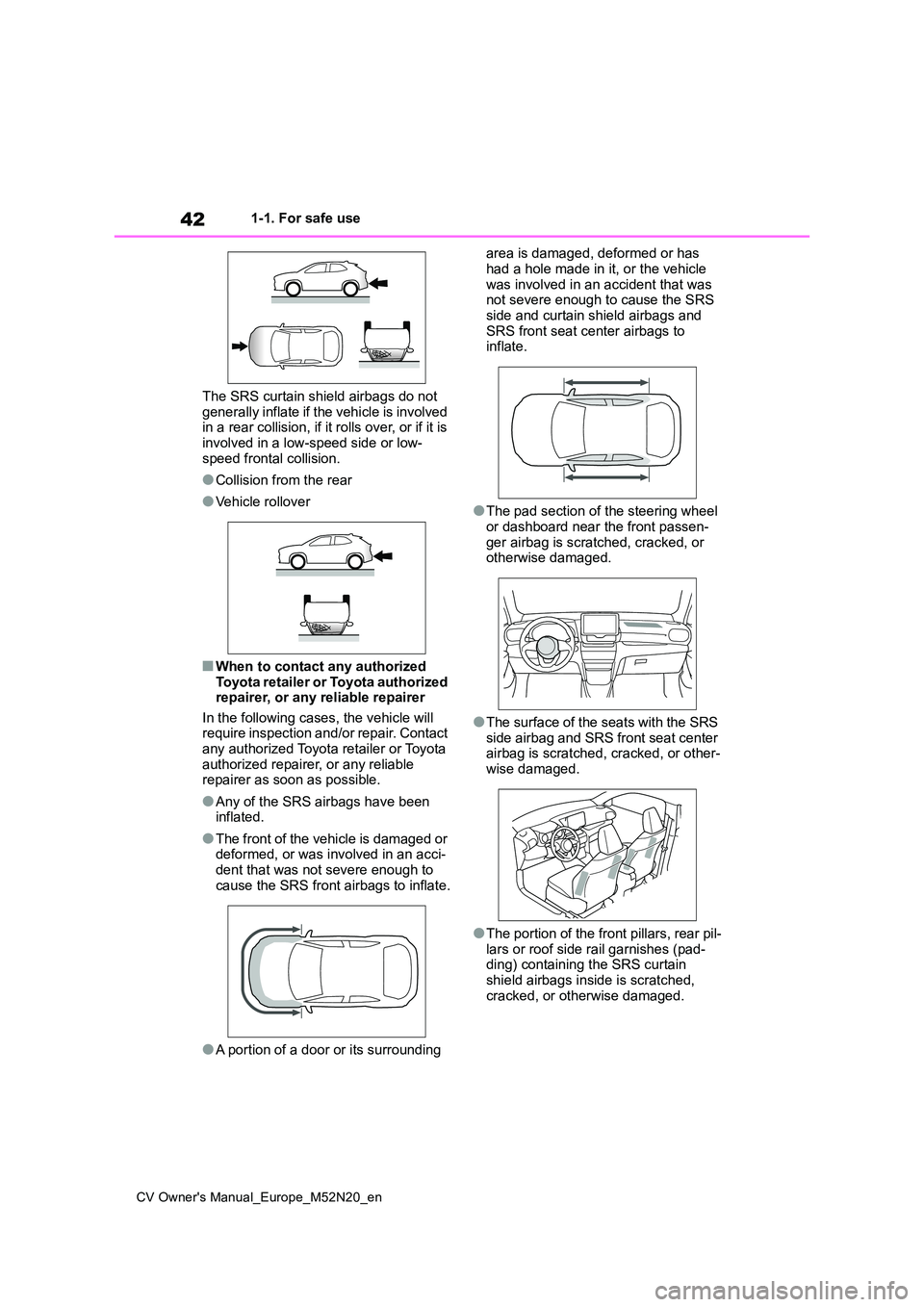2022 TOYOTA YARIS CROSS steering wheel
[x] Cancel search: steering wheelPage 4 of 618

2
CV Owner's Manual_Europe_M52N20_en
TABLE OF CONTENTS
For your information ........................6
Reading this manual........................ 9
How to search ............................... 10
Pictorial index ................................ 12
1-1. For safe use
Before driving........................ 32
For safe driving ..................... 33
Seat belts .............................. 35
SRS airbags.......................... 38
Exhaust gas precautions ...... 46
1-2. Child safety
Airbag manual on-off system 47
Riding with children............... 48
Child restraint systems ......... 49
1-3. Emergency assistance
eCall...................................... 65
1-4. Theft deterrent system
Engine immobilizer system ... 75
Double locking system .......... 76
Alarm .................................... 77
2-1. Instrument cluster
Warning lights and indicators 80
Gauges and meters (4.2-inch
display) ............................... 85
Gauges and meters (7-inch dis-
play) .................................... 89
Multi-information display (4.2-
inch display)........................ 94
Multi-information display (7-inch
display) ............................. 100
Head-up display .................. 106
Fuel consumption information
.......................................... 110
3-1. Key information
Keys .................................... 114
3-2. Opening, closing and locking
the doors
Side doors........................... 119
Back door............................ 123
Smart entry & start system . 136
3-3. Adjusting the seats
Front seats .......................... 141
Rear seats .......................... 142
Head restraints ................... 144
3-4. Adjusting the steering wheel
and mirrors
Steering wheel .................... 148
Inside rear view mirror ........ 149
Outside rear view mirrors.... 150
1For safety and security
2Vehicle status information
and indicators
3Before driving
Page 6 of 618

4
CV Owner's Manual_Europe_M52N20_en
TABLE OF CONTENTS
5-1. Using the air conditioning
system and defogger
Manual air conditioning system
.......................................... 312
Automatic air conditioning sys-
tem .................................... 316
Heated steering wheel/seat
heaters.............................. 322
5-2. Using the interior lights
Interior lights list .................. 324
5-3. Using the storage features
List of storage features ....... 326
Luggage compartment features
.......................................... 329
5-4. Other interior features
Other interior features ......... 333
6-1. Maintenance and care
Cleaning and protecting the
vehicle exterior ................. 342
Cleaning and protecting the
vehicle interior .................. 345
6-2. Maintenance
Maintenance requirements . 348
6-3. Do-it-yourself maintenance
Do-it-yourself service precau-
tions .................................. 350
Hood ................................... 351
Positioning a floor jack ........ 353
Engine compartment........... 354
Tires .................................... 363
Tire inflation pressure ......... 373
Wheels ................................ 374
Air conditioning filter ........... 376
Wireless remote control/elec-
tronic key battery .............. 378
Checking and replacing fuses
.......................................... 381
Light bulbs .......................... 386
7-1. Essential information
Emergency flashers ............ 394
If your vehicle has to be stopped
in an emergency ............... 394
If the vehicle is submerged or
water on the road is rising 395
5Interior features
6Maintenance and care
7When trouble arises
Page 19 of 618

17
CV Owner's Manual_Europe_M52N20_en
Pictorial index
■Switches (left-hand drive vehicles)
Window lock switch .......................................................................P.155
Outside rear view mirror switches .............................. .................P.150
Door lock switches ............................................. ...........................P.122
Power window switches .......................................... ......................P.153
Headlight leveling dial*............................................................... ...P.194
Power back door switch*............................................................... P. 1 2 6
Windshield wiper de-icer switch*.........................................P.314, 320
Heated steering wheel switch*......................................................P.322
Automatic High Beam switch*......................................................P.201
Adaptive High-beam System switch*...........................................P.197
Brake hold switch .............................................. ............................P.190
Parking brake switch ........................................... ..........................P.186
Page 27 of 618

25
CV Owner's Manual_Europe_M52N20_en
Pictorial index
■Switches (right-hand drive vehicles)
Outside rear view mirror switches ...............................................P.150
Window lock switch ............................................. ..........................P.155
Door lock switches ............................................. ...........................P.122
Power window switches .......................................... ......................P.153
Headlight leveling dial*............................................................... ...P.194
Power back door switch*............................................................... P. 1 2 6
Automatic High Beam switch*......................................................P.201
Adaptive High-beam System switch*...........................................P.197
Heated steering wheel switch*......................................................P.322
Brake hold switch .............................................. ............................P.190
Parking brake switch ........................................... ..........................P.186
Precautions against winter season .............................. ....................P.308
Page 35 of 618

33
1
CV Owner's Manual_Europe_M52N20_en
1-1. For safe use
For safety and security
Adjust the angle of the seatback
so that you are sitting straight up
and so that you do not have to
lean forward to steer. ( P.141)
Adjust the seat so that you can
depress the pedals fully and so
that your arms bend slightly at
the elbow when gripping the
steering wheel. ( P.141)
Lock the head restraint in place
with the center of the head
restraint closest to the top of
your ears. ( P. 1 4 4 )
Wear the seat belt correctly.
( P. 3 5 )
WARNING
●With the engine stopped and the shift lever in P (Multidrive) or N
(manual transmission), fully depress each pedal to the floor to make sure it does not interfere with
the floor mat.
For safe driving
For safe driving, adjust the
seat and mirror to an appropri-
ate position before driving.
Correct driving posture
Page 42 of 618

40
CV Owner's Manual_Europe_M52N20_en
1-1. For safe use
“PASSENGER AIR BAG” indicator
Airbag sensor assembly
The main SRS airbag system components are shown above. The SRS air-
bag system is controlled by the airbag sensor assembly. As the airbags
deploy, a chemical reaction in the inflators quickly fills the airbags with non-
toxic gas to help restrain the motion of the occupants.
■If the SRS airbags deploy (inflate)
●Slight abrasions, burns, bruising etc., may be sustained from SRS airbags,
due to the extremely high speed deployment (inflation) by hot gases.
●A loud noise and white powder will be emitted.
●Parts of the airbag module (steering wheel hub, airbag cover and inflator) as well as the front seats, parts of the
front and rear pillars, and roof side rails, may be hot for several minutes.
The airbag itself may also be hot.
●The windshield may crack.
●The brakes and stop lights will be con- trolled automatically. ( P.301)
●The interior lights will turn on automat- ically. ( P.325)
●The emergency flashers will turn on automatically. ( P.394)
●Fuel supply to the engine will be stopped. ( P.402)
●Vehicles with eCall: If any of the fol-
lowing situations occur, the system is
designed to send an emergency call* to the eCall control center, notifying them of the vehicle’s location (without
needing to push the “SOS” button) and an agent will attempt to speak with the occupants to ascertain the
level of emergency and assistance required. If the occupants are unable to communicate, the agent automati-
cally treats the call as an emergency and helps to dispatch the necessary emergency services. ( P.65)
• An SRS airbag is deployed. • A seat belt pretensioner is activated.
• The vehicle is involved in a severe rear-end collision.*: In some cases, the call cannot be
made. ( P. 6 6 )
■SRS airbag deployment conditions (SRS front airbags)
●The SRS front airbags will deploy in the event of an impact that exceeds
the set threshold level (the level of force corresponding to an approxi-mately 20 - 30 km/h [12 - 18 mph]
frontal collision with a fixed wall that does not move or deform).
However, this threshold velocity will be considerably higher in the following situ-ations:
• If the vehicle strikes an object, such as a parked vehicle or sign pole, which can move or deform on impact
• If the vehicle is involved in an under- ride collision, such as a collision in which the front of the vehicle “under-
rides”, or goes under, the bed of a truck
●Depending on the type of collision, it is possible that only the seat belt pretensioners will activate.
■SRS airbag deployment conditions
(SRS side and curtain shield air- bags and SRS front seat center air-bags)
●The SRS side and curtain shield air-bags and SRS front seat center air-
bags will deploy in the event of an impact that exceeds the set threshold level (the level of force corresponding
to the impact force produced by an approximately 1500 kg [3300 lb.] vehi-cle colliding with the vehicle cabin
Page 44 of 618

42
CV Owner's Manual_Europe_M52N20_en
1-1. For safe use
The SRS curtain shield airbags do not
generally inflate if the vehicle is involved in a rear collision, if it rolls over, or if it is involved in a low-speed side or low-
speed frontal collision.
●Collision from the rear
●Vehicle rollover
■When to contact any authorized Toyota retailer or Toyota authorized repairer, or any reliable repairer
In the following cases, the vehicle will require inspection and/or repair. Contact any authorized Toyota retailer or Toyota
authorized repairer, or any reliable repairer as soon as possible.
●Any of the SRS airbags have been inflated.
●The front of the vehicle is damaged or deformed, or was involved in an acci-dent that was not severe enough to
cause the SRS front airbags to inflate.
●A portion of a door or its surrounding
area is damaged, deformed or has
had a hole made in it, or the vehicle was involved in an accident that was not severe enough to cause the SRS
side and curtain shield airbags and SRS front seat center airbags to inflate.
●The pad section of the steering wheel or dashboard near the front passen-
ger airbag is scratched, cracked, or otherwise damaged.
●The surface of the seats with the SRS side airbag and SRS front seat center airbag is scratched, cracked, or other-
wise damaged.
●The portion of the front pillars, rear pil-
lars or roof side rail garnishes (pad- ding) containing the SRS curtain shield airbags inside is scratched,
cracked, or otherwise damaged.
Page 45 of 618

43
1
CV Owner's Manual_Europe_M52N20_en
1-1. For safe use
For safety and security
WARNING
■SRS airbag precautions
Observe the following precautions
regarding the SRS airbags. Failure to do so may cause death or serious injury.
●The driver and all passengers in the vehicle must wear their seat belts
properly. The SRS airbags are supplemental devices to be used with the seat
belts.
●The SRS driver airbag deploys with
considerable force, and can cause death or serious injury especially if the driver is very close to the air-
bag.
Since the risk zone for the driver’s air-
bag is the first 50 - 75 mm (2 - 3 in.) of
inflation, placing yourself 250 mm (10
in.) from your driver airbag provides
you with a clear margin of safety. This
distance is measured from the center
of the steering wheel to your breast-
bone. If you sit less than 250 mm (10
in.) away now, you can change your
driving position in several ways:
• Move your seat to the rear as far as you can while still reaching the ped-als comfortably.
• Slightly recline the back of the seat.Although vehicle designs vary, many drivers can achieve the 250
mm (10 in.) distance, even with the driver seat all the way forward, sim-ply by reclining the back of the seat
somewhat. If reclining the back of your seat makes it hard to see the road, raise yourself by using a firm,
non-slippery cushion, or raise the seat if your vehicle has that feature.
• If your steering wheel is adjustable, tilt it downward. This points the air-bag toward your chest instead of
your head and neck.
The seat should be adjusted as rec-
ommended above, while still main- taining control of the foot pedals, steering wheel, and your view of the
instrument panel controls.
●The SRS front passenger airbag
also deploys with considerable force, and can cause death or seri-ous injury especially if the front pas-
senger is very close to the airbag. The front passenger seat should be as far from the airbag as possible
with the seatback adjusted, so the front passenger sits upright.
●Improperly seated and/or restrained infants and children can be killed or seriously injured by a deploying air-
bag. An infant or child who is too small to use a seat belt should be properly secured using a child
restraint system. Toyota strongly recommends that all infants and children be placed in the rear seats
of the vehicle and properly restrained. The rear seats are safer for infants and children than the
front passenger seat. ( P. 4 9 )